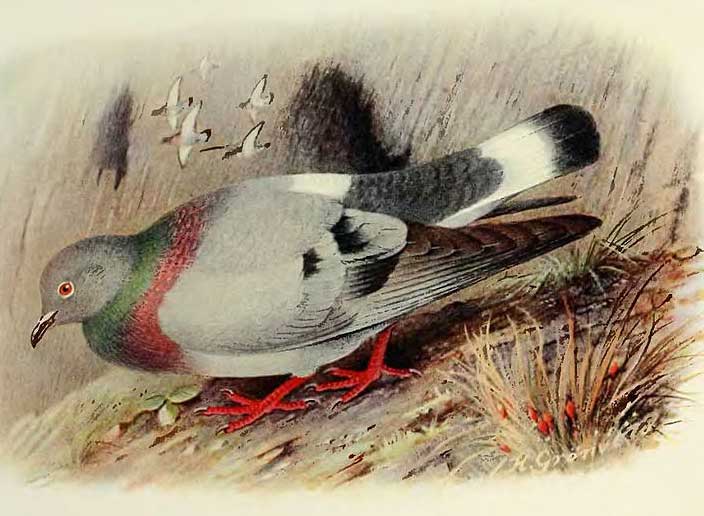
Columba rupestris
Superregnum: Eukaryota
Cladus: Unikonta
Cladus: Opisthokonta
Cladus: Holozoa
Regnum: Animalia
Subregnum: Eumetazoa
Cladus: Bilateria
Cladus: Nephrozoa
Superphylum: Deuterostomia
Phylum: Chordata
Subphylum: Vertebrata
Infraphylum: Gnathostomata
Megaclassis: Osteichthyes
Cladus: Sarcopterygii
Cladus: Rhipidistia
Cladus: Tetrapodomorpha
Cladus: Eotetrapodiformes
Cladus: Elpistostegalia
Superclassis: Tetrapoda
Cladus: Reptiliomorpha
Cladus: Amniota
Classis: Reptilia
Cladus: Eureptilia
Cladus: Romeriida
Subclassis: Diapsida
Cladus: Sauria
Infraclassis: Archosauromorpha
Cladus: Crurotarsi
Divisio: Archosauria
Cladus: Avemetatarsalia
Cladus: Ornithodira
Subtaxon: Dinosauromorpha
Cladus: Dinosauriformes
Cladus: Dracohors
Cladus: Dinosauria
Ordo: Saurischia
Cladus: Eusaurischia
Subordo: Theropoda
Cladus: Neotheropoda
Cladus: Averostra
Cladus: Tetanurae
Cladus: Avetheropoda
Cladus: Coelurosauria
Cladus: Tyrannoraptora
Cladus: Maniraptoromorpha
Cladus: Maniraptoriformes
Cladus: Maniraptora
Cladus: Pennaraptora
Cladus: Paraves
Cladus: Eumaniraptora
Cladus: Avialae
Infraclassis: Aves
Cladus: Euavialae
Cladus: Avebrevicauda
Cladus: Pygostylia
Cladus: Ornithothoraces
Cladus: Ornithuromorpha
Cladus: Carinatae
Parvclassis: Neornithes
Cohors: Neognathae
Cladus: Neoaves
Cladus: Columbimorphae
Ordo: Columbiformes
Familia: Columbidae
Subfamilia: Columbinae
Genus: Columba
Species: Columba rupestris
Subspecies: C. r. rupestris – C. r. turkestanica
Name
Columba rupestris Pallas, 1811
References
Zoographia Rosso-Asiatica 1: 560.
Vernacular names
čeština: Holub útesový
English: Hill Pigeon
Esperanto: Montarkolombo
español: Paloma rupestre
suomi: Aasiankalliokyyhky
magyar: Sziklagalamb
The hill pigeon, eastern rock dove, or Turkestan hill dove (Columba rupestris) is a species of bird in the family Columbidae.
Description
The hill pigeon is a stout-bodied pigeon, similar in size and general appearance to the rock dove but mainly differentiated by its tail pattern which consist of a broad, white tail-band across the black tail. Other differences include a paler mantle and upper wings and a white patch on the back. In flight, the tail pattern is similar to the snow pigeon, but lacks the contrast between the head and neck in that species.
Taxonomy and systematics
Two subspecies are recognized:
The blue hill pigeon (C. r. rupestris), described by Pallas, is found in the eastern range of the species' distribution.
The Turkestan hill pigeon (C. r. turkestanica), described by Buturlin, is found in the western range of the species' distribution.
Distribution and status
It is found in China, Pakistan, India, Nepal, Kazakhstan, North Korea, South Korea, Mongolia, Russia, Tajikistan, Afghanistan, and Turkmenistan. This pigeon is comparatively restricted in range of Pakistan to the furthest northern inner valleys of the Karakoram, Hindu Kush, and Pamirs. In Pakistan, it occurs in northern Chitral, particularly in the western part bordering Nuristan in Afghanistan, further east in valleys of Gilgit in Yasin and Hunza and Karakoram ranges in Baltistan from about 2000 m in winter up to 5500 m during summer. Though the overall population is decreasing, the rate of decrease is not alarming and the bird is widely distributed and abundant; it is classified as least concern by the IUCN.[1]
Behaviour and ecology
This species frequents open rugged country from 1,500 to 6,100 m above sea level. They are closely related to rock doves, but more commonly are found at higher altitudes.[2] A gregarious species throughout the year, they feed in flocks in the terraced, cultivated fields. They often mix with flocks of rock doves. They are very tame and are often found near human settlements, camps, and pilgrimage routes.[3]
In Tajikistan, it has been recorded as starting to nest as early as February, with many young just fledging as late as September in northeastern Tibet. The males have a bowing display similar to that of the rock dove and display and courtship is similar. They nest in dense colonies on cliffs, gorges, and rocky outcrops. In Tibet, the nests are often placed in houses, both inhabited and empty, or in holes in the wall.[4] Nests consist of a platform of twigs or plant stems in which generally two eggs are laid. They may raise two brood in a year.[4]
Their feeding habits are similar to rock doves, being mainly granivorous, supplementing their diet with green shoot and leaves and occasionally small mollusks such as snails. On some occasions, they become very opportunistic, feeding on leftover food, partially digested food from kiang dung, and even undigested food from stomach of kiang carcasses which are ripped open by other predators.[5]
References
BirdLife International (2016). "Columba rupestris". IUCN Red List of Threatened Species. 2016: e.T22690074A93259855. doi:10.2305/IUCN.UK.2016-3.RLTS.T22690074A93259855.en. Retrieved 11 November 2021.
Gibbs, David; Eustace Barnes; John Cox (2001). Pigeons and Doves: A Guide to the Pigeons and Doves of the World. United Kingdom: Pica Press. p. 624. ISBN 1-873403-60-7.
Rasmussen PC & JC Anderton (2005). Birds of South Asia: The Ripley Guide. Volume 2. Smithsonian Institution & Lynx Edicions. p. 205.
Baker, ECS (1928). Fauna of British India. Birds. Vol. 5 (2nd ed.). Taylor and Francis, London. pp. 222–223.
Francis M.; Clement (2005). "Birds of Ladakh". Indian Birds. 1 (5): 109–114.
Retrieved from "http://en.wikipedia.org/"
All text is available under the terms of the GNU Free Documentation License

